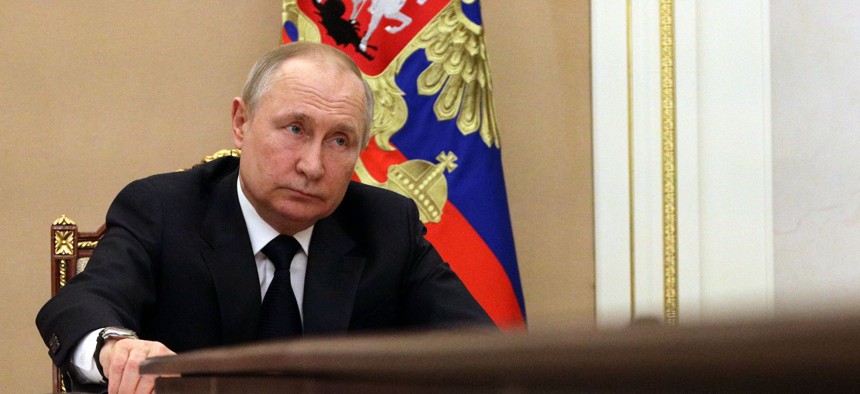
Russian President Vladimir Putin chairs a meeting with members of the Russian government via teleconference in Moscow on March 10, 2022. Sputnik / AFP via Getty Images / MIKHAIL KLIMENTYEV
How to Stop Putin Without Starting WWIII
The greatest risk the United States and European countries face right now is mission creep from their own desire to do more.
Putin’s aggression must be stopped, but Washington is atwitter with dangerous ideas about how to do so, like establishing a no-fly zone over Ukraine, which would require shooting down Russian planes. The United States and other European countries must demonstrate a heavy cost to Putin’s invasion to deter future aggression, but without risking direct conflict. Putin has badly miscalculated and is already paying a heavy price for the invasion. The United States and NATO allies have two objectives at the moment: deterring future Russian aggression by demonstrating a heavy cost to this invasion; and avoiding direct conflict with Russia. During the Cold War, the United States resisted the Soviet Union in proxy conflicts around the globe without coming to direct blows. The same carefully calibrated response is needed to Russia’s invasion of Ukraine. The United States and other NATO countries should aid Ukraine through weapons, intelligence, and diplomatic support, but should stay clear of direct involvement in the war.
Several ideas have recently been floated that risk implicating the United States and/or NATO in the conflict. The most dangerous of these is a no-fly zone, advocated by a number of former U.S. military and civilian government officials. Enforcing a no-fly zone would require U.S. and NATO warplanes to patrol over Ukrainian territory, well within range of Russian air defenses, and shoot down Russian aircraft that violate the no-fly zone. The United States would kill Russian pilots and would likely have to attack Russian air defenses, potentially on Russian soil. Russia would kill American pilots. A no-fly zone would put the United States and Russia at war with one another. There is no “limited” no-fly zone option, protecting humanitarian corridors or some other limited mission, that would avoid this stark reality.
Enforcing a no-fly zone would risk World War III and for little gain. The bulk of Russia’s offensive firepower comes from ground forces and surface-to-surface missiles, not airpower. In the unlikely event that the United States actually carried out a no-fly zone, it would do little to tilt the balance on the ground, potentially leading to further calls to expand U.S. air operations to include a “no-drive zone” in which U.S. warplanes attacked Russian ground forces.
In another possible escalatory move, Poland recently floated the idea of transferring its MiG-29 fighter jets to Ukraine via the United States, an idea that was promptly shot down by the Pentagon. While the United States is already supplying Ukraine with massive amounts of arms, including over 17,000 anti-tank weapons, over land from bordering NATO countries, transferring fighter jets is a riskier step. For one, sending the aircraft would be a highly visible sign of support and could incur Russian retaliation, dragging NATO closer to conflict. More importantly, they are unlikely to dramatically change the course of the conflict. In theory, Ukrainian aircraft could attack vulnerable Russian convoys. In reality, to effectively operate their aircraft, Ukraine also needs pilots, maintainers, fuel, and serviceable runways. One risk in sending fighter jets is that, given that Ukrainian airbases are under Russian attack, Ukraine will next request to base its aircraft in a neighboring country. Allowing Ukrainian aircraft to fly from a NATO country would directly implicate the alliance in the conflict, inviting Russian retaliation. While far less escalatory than a no-fly zone, sending MiGs increases NATO involvement without much changing the conflict.
As another potential response to the tragedy unfolding in Ukraine, some experts have proposed establishing a humanitarian safe zone in western Ukraine in territory not currently occupied by Russian forces, including the city of Lviv. This safe zone would be defended by some combination of U.S., NATO, and EU forces, perhaps sanctioned by the UN. The intent would be to provide a safe territory for displaced Ukrainians and halt Putin’s further advancement westward.
Regardless of its defensive intent, the reality is that by establishing a safe zone the United States would be entering the conflict with the intent of carving up Ukraine, splitting it into Russian-dominated and U.S./NATO/EU-dominated sections. How should Russia and the U.S./NATO/EU bloc divide the country? Would they agree on borders? How do they deconflict their military forces? The risks of miscalculation and escalation are massive, especially considering Putin’s willingness to take risks and his pattern of unrealistic assumptions about his own military forces’ abilities. Border skirmishes and occasional shelling between Russian and U.S./NATO/EU forces would be highly likely, running the risk that the inevitable friction between the two forces could lead to an escalatory incident.
Even if Russia and NATO could successfully divide up Ukraine without coming to blows, such a move would trap the United States indefinitely in Ukraine’s frozen conflict as protector of western Ukraine. Regardless of pledges to the contrary, it is hard to imagine preventing the safe zone being used as a transit point for weapons into Ukraine while fighting is underway. And if Russian occupation of eastern Ukraine spawned an insurgency, western Ukraine would almost certainly be the launching pad for weapons and fighters into Russian-occupied territory, risking Russian retaliation and further flare ups in the conflict over time. Western Ukrainians and international supporters would not be satisfied with a divided Ukraine, but would seek to expel Russia and reunite the country.
Moreover, effective “safe zones” already exist in neighboring countries, including those protected by NATO’s Article 5 commitment. Over two million Ukrainian refugees have already sought safe haven in other European countries, including 1.4 million in Poland. Forcibly establishing a buffer zone in western Ukraine is not needed to stop Putin. There is no need to draw a line indicating to Putin where his aggression must stop. That line exists: NATO’s border. What the United States and other NATO countries must do is demonstrate to Putin that NATO has the capability, resolve, and will to defend “every inch of NATO territory,” as Biden has pledged.
Don't miss:
Steps that partially commit U.S. troops to the conflict, such as a no-fly zone or safe zone in western Ukraine, are not only dangerous in their own right, but invite deeper U.S. involvement when these measures turn out not to actually have the desired effect of ensuring Ukraine’s independence and protecting civilians. When a no-fly zone fails to stop Russian artillery and missile attacks, the obvious next step would be to escalate to bombing Russian ground forces. When a safe zone in western Ukraine doesn’t stop Russia from swallowing up most of the country, the next step would be to roll-back Russian advances and liberate the rest of Ukraine.
The proposals themselves are examples of the pressure towards mission creep already in action. Prior to Russia’s invasion, the United States could have put U.S. troops into Ukraine, committing the United States to its defense. Yet not only did the United States not commit forces, it withdrew military advisors and President Biden explicitly ruled out sending U.S. troops to confront Russia. Now, when the consequences of that choice are made evident in Russia’s invasion and attacks on Ukrainian civilians, well-meaning U.S. commentators grasp for actions that might help stop the bloodshed.
There is no magic solution, no gadget the United States can send Ukraine or limited step it can take to aid them that will ensure Ukrainian victory. While the Russian military has displayed remarkable incompetence in its prosecution of the conflict so far and Ukrainians have fought fiercely, the reality is that Russia has vastly superior numbers and firepower. Territorial gains to date have been largely one-sided, with Ukraine slowing but not stopping the Russian advance.
The U.S. strategy of aiding Ukraine while staying out of direct conflict is a strategy that necessarily risks Ukraine’s defeat. Yet the United States is not responsible for Ukraine’s security. Ukraine is not a member of NATO. U.S. aims should be to make Russia’s invasion so costly – politically, militarily, and economically – that Putin is deterred from future aggression. But the U.S. goal is not, and should not be, to defend Ukraine at all costs.
The human tragedy unfolding in Ukraine is profound. The Ukrainian people deserve to be free, and the United States has both moral and political reasons to support them, but not at the cost of going to war with Russia.
The best U.S. approach is what the United States is already doing: supplying Ukraine with large numbers of anti-tank and anti-aircraft weapons, including relatively sophisticated Javelin and Stinger missiles. These missiles are highly portable, relatively easy to operate, and can be employed by small teams operating dispersed and independently. They are well within the capacity of Ukrainian defenders and don’t require further assistance from NATO once the weapons have been transferred. If greater airpower for air-to-ground attacks is needed, the Turkish-made Bayraktar TB2 drone, which Ukraine already has employed in a limited fashion against Russian ground forces, is likely a more useful and less escalatory option than sending fighter jets. If greater air defense capability is needed, Soviet-made mobile air defense systems that the Ukrainian military has familiarity with could be valuable, although it would be better if they were transferred quietly.
While the United States has been slow—across multiple presidential administrations—in arming Ukraine before the invasion, the Biden administration has quickly adapted over the past two weeks. Since the invasion, the U.S. has swiftly sent Ukraine large numbers of anti-tank weapons, which is what they need the most. Most importantly, the administration has been measured and prudent in their response and avoided mission creep. Putin has made a terrible blunder in invading Ukraine. The United States should not commit its own by stumbling into war.
Paul Scharre is vice president and director of studies at the Center for a New American Security and a former Army Ranger with service in Iraq and Afghanistan. He is the author of Army of None: Autonomous Weapons and the Future of War.




